Caleana major
| Flying duck orchid | |
|---|---|

| |
| Scientific classification | |
| Kingdom: | Plantae |
| Clade: | Tracheophytes |
| Clade: | Angiosperms |
| Clade: | Monocots |
| Order: | Asparagales |
| Family: | Orchidaceae |
| Subfamily: | Orchidoideae |
| Tribe: | Diurideae |
| Genus: | Caleana |
| Species: | C. major
|
| Binomial name | |
| Caleana major | |
| Synonyms | |
| |
Caleana major, commonly known as the large duck orchid,[1] is a small orchid found in eastern and southern Australia.[2] This terrestrial plant features a remarkable flower, resembling a duck in flight. The flower is an attractant to insects, such as male sawflies which pollinate the flower in a process known as pseudocopulation.[2] In 1986 this orchid was featured on an Australian postage stamp.[3]
Caleana major is the emblem of the Latrobe Valley Field Naturalists Club.[4]
Description[edit]
Caleana major is a tuberous, perennial herb, usually growing to a height of 200–400 mm (8–20 in) with a single reddish, narrow lance-shaped leaf, 40–130 mm (2–5 in) long, 4–8 mm (0.2–0.3 in) wide and often spotted, emerging at its base. Up to five shiny reddish brown flowers, 20–25 mm (0.8–1 in) long and 6–7 mm (0.2–0.3 in) wide are borne on a thin, wiry flowering stem. (In rare cases, the flower can be greenish with dark spots.) The sepals and petals are 12–15 mm (0.5–0.6 in) long and have pointed tips. The column has broad wings which the dorsal sepal and petals almost touch and the lateral sepals turn back wing-like behind the flower. The labellum is 6–8 mm (0.2–0.3 in) long and 5–6 mm (0.20–0.24 in) wide and resembles the head of a duck on a strap-like "neck". Flowering occurs from September to January.[1][5][6][7]
Taxonomy and naming[edit]
Caleana major was first formally described in 1810 by Robert Brown from a specimen he collected at Port Jackson, Bennelong Point in September 1803. The description was published in Prodromus Florae Novae Hollandiae et Insulae Van Diemen.[8][9] The genus name (Caleana) honours George Caley, an early botanical collector[10][11] and the specific epithet (major) is a Latin word meaning "large" or "great".[12]
Distribution and habitat[edit]
The flying duck orchid occurs in Queensland, New South Wales, Victoria, South Australia and Tasmania,[11][13] growing in eucalyptus woodland, coastal or swampy shrubland and heathland. Mostly near the coast, but occasionally at higher altitudes.[5]
Ecology[edit]
The plant is pollinated by insects. The labellum is held above the flower by a sensitive strap-like stalk. When touched, the labellum turns rapidly downward, trapping a visiting insect between the labellum and column wings.[6][14]
Cultivation[edit]
Caleana major has been difficult to maintain in cultivation. Plants flower for one or sometimes two years but progressively weaken until they die.[11]
References[edit]
- ^ a b Jeanes, Jeff. "Caleana major". Royal Botanic Gardens Victoria. Retrieved 12 April 2018.
- ^ a b Les Robinson - Field Guide to the Native Plants of Sydney, ISBN 978-0-7318-1211-0 page 241
- ^ "Australian Plants on Stamps". Australian National Botanic Garden. Retrieved 12 April 2018.
- ^ "History". Latrobe Valley Field Naturalists Club. Retrieved 2024-02-27.
- ^ a b Bernhardt, Peter. "Caleana major". Royal Botanic Garden Sydney. Retrieved 12 April 2018.
- ^ a b Jones, David L. (2006). A complete guide to native orchids of Australia including the island territories. Frenchs Forest, N.S.W.: New Holland. p. 146. ISBN 1877069124.
- ^ "Caleana major". Friends of Lane Cove National Park Inc. Archived from the original on 3 March 2016. Retrieved 12 April 2018.
- ^ "Caleana major". APNI. Retrieved 12 April 2018.
- ^ Clements, Mark A. (1989). "Catalogue of Australian Orchidaceae". Australian Orchid Research. 1: 33.
- ^ Brown, Robert (1810). Prodromus florae Novae Hollandiae et insulae Van-Diemen, exhibens characteres plantarum quas annis 1802-1805. London. pp. 322–329. Retrieved 12 April 2018.
- ^ a b c Elliot, Rodger W.; Jones, David L.; Blake, Trevor (1985). Encyclopaedia of Australian Plants Suitable for Cultivation: Vol. 2. Port Melbourne: Lothian Press. p. 408. ISBN 0-85091-143-5.
- ^ Brown, Roland Wilbur (1956). The Composition of Scientific Words. Washington, D.C.: Smithsonian Institution Press. p. 461.
- ^ "Australian Orchids in New Zealand, National Library of New Zealand".
- ^ Fairley, Alan; Moore, Philip (2010). Native Plants of the Sydney Region: An Identification Guide (3rd ed.). Crows Nest, NSW: Jacana Books (Allen & Unwin). p. 563. ISBN 978-1-74175-571-8.
External links[edit]
 Media related to Caleana major at Wikimedia Commons
Media related to Caleana major at Wikimedia Commons
